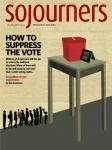WE HAVE AMPLE reason to weep of late: war in Gaza, crisis in Syria, ISIS in Iraq, the slaying of five unarmed black men in one month at the hands of U.S. police officers, and the demise of congressional immigration reform.
Scripture calls us to cross over into the valley of lament at times such as these. Yet most of us are more comfortable on the plateau of rage or the plain of apathy.
I once led a training on lament and racial reconciliation. Twenty college students sat in the living room of a ministry house as I recited a lament from Jeremiah, the “weeping prophet”: “O that my head were a spring of water, and my eyes a fountain of tears, so that I might weep day and night for the slain of my poor people!” (9:1).
I spoke of the impact of racial injustice in our nation and on our campuses. I recounted slave narratives to the students—stories that had brought me to tears privately. Yet, when the last word was read, the students sat silent with glazed eyes staring back at me.
I didn’t get it. The whippings of human beings, the children separated from their mothers and fathers, the hands, feet, and lives lost in the midst of America’s darkest hours—these things happened. How could we not lament?
My new book, Forgive Us: Confessions of a Compromised Faith, co-authored with Soong-Chan Rah, Mae Cannon, and Troy Jackson, opens with teachings on the value, purpose, and practice of lament and confession (see excerpt, page 46). “The church tends to view itself as the world’s problem solver,” we suggest. “This belief ... results in a diminishing of, or a blindness to, lament and the necessary confession that is inherent within it.”
Years ago I told sad stories, trying to jerk tears from the faces of young people who knew very little about the institution of U.S. slavery and had no sense of our collective American and Christian responsibility for and benefit from it. To the students, they were just sad stories. I get it now. Distant historical sin is internalized intellectually, and it’s a long jump for most to make to soften hearts for lament and repentance. Thus, hot words fell on stone hearts in that living room.
Flash forward: One week after returning from Ferguson, Mo., where I spent a week traversing the city organizing evangelical pastors to engage the struggle by day and marching with protesters by night—the tears came.
A police car whizzed by with its siren on blast and lights blaring. Intractable Ferguson police and flanks of white men in uniform pointed guns at children, mothers, and fathers who marched simply to say that what happened to their son, friend, nephew was wrong. Images of Michael Brown lying dead in the street for four hours, blood streaming from his head mixed with tar under his face, and the sound of his mother’s blood-curdling scream as the police prevented her from placing a white sheet over her son’s dead body—these moments haunted me.
Memories of the chorus of faith leaders who confessed their culpability in the killing of Michael Brown came to mind. Each said, “Forgive us.” Bernice King’s confession was the most profound. The daughter of Martin Luther King Jr., repented: “Since my father’s assassination, we have been asleep.” I wept. Oh, God, forgive us. You called us to be shalom-doers in our land, yet we have only sought our own prosperity. Our ancestors marched, bled, and died for the vote, but we have squandered it. These are the reasons five young lives—Michael Brown, Ezell Ford, Eric Garner, John Crawford, and Dante Parker—are gone.
Rev. Traci Blackmon, pastor of Christ the King UCC in Florissant, a town neighboring Ferguson, recently reported how local women took to the streets in the community where Michael Brown lived. “To drum beats that called to us from the Motherland,” Blackmon wrote, “we sang, we prayed, we cried, we screamed, we cussed, we held on to one another ... we began the journey back ... with the residents leading the way.”
This is the valley of lament. Oh, God, help us all cross over.

Got something to say about what you're reading? We value your feedback!
